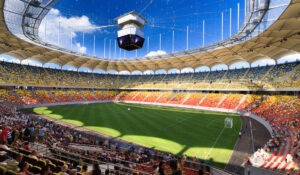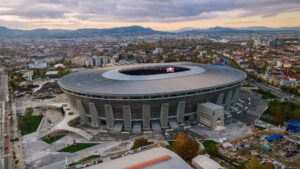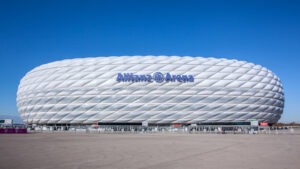UEFA Euro 2020 Stadiums List
The 16th UEFA European Championship to be held in 11 cities in 11 different UEFA countries. The tournament is scheduled for 11 June to 11 July 2021. Although it is the EURO 2020 but it is going to take part in 2021 due to the COVID-19 pandemic the original schedule was changed.
Three group stage matches and one match in the round of 16 or quarter-finals will be hosted by each city. 11 cities in 11 different UEFA countries will be the venues for Euro 2020. The list is below:
| STADIUM | CITY | COUNTRY | CAPACITY |
| Wembley Stadium | Lusail | England | 90,000 |
| Stadio Olimpico | Rome | Italy | 70,634 |
| Olympic Stadium | Baku | Azerbaijan | 68,700 |
| Krestovsky Stadium | Saint Petersburg | Russia | 68,134 |
| La Cartuja | Seville | Spain | 60,000 |
| Arena Națională | Bucharest | Romania | 55,600 |
| Johan Cruyff Arena | Amsterdam | Netherlands | 54,990 |
| Hampden Park | Glasgow | Scotland | 51,866 |
| Parken Stadium | Copenhagen | Denmark | 38,065 |
| Puskás Aréna | Budapest | Hungary | 67,215 |
| Allianz Arena | Munich | Germany | 70,000 |
Wembley Stadium

Opened on 9 March 2007 Wembley Stadium is located at Wembley, London. It has a capacity of 90,000 and 86,000 to 87,000 for UEFA. This stadium does not have a retractable roof that covers the playing surface. This stadium will host 8 matches including the 16 semi-finals and the final. It is one of the biggest football stadiums in the world.
Stadio Olimpico

The largest sports facility in Rome, Italy Stadio Olimpico is located within the Foro Italico sports complex. on the north side of the city. This stadium has a capacity of 70,634. This stadium has hosted 4 Europian cup finals and is rated as a UEFA category four stadium.
Olympic Stadium

Opened on 6 March 2015 Olympic Stadium is designed and constructed to meet international standards. It has a 69,870 seat capacity. The stadium contains VVIP, VIP – CIP Suites total of 127 each with 720 spectators capacity and total car parking capacity for 3,078 cars.
Krestovsky Stadium

This stadium was built as one of the venues for the 2018 FIFA World Cup. It has a seating capacity of 67,800 and 105 x 68 m field size. This stadium features a retractable pitch with a retractable roof. It was opened on 22 April 2017 and the construction cost was $660 million.
La Cartuja

situated in the Isla de la Cartuja in Seville, Spain Estadio La Cartuja de Sevilla is a multi-purpose stadium with a 60,000 seat capacity. Being the 6th-largest stadium in Spain La Cartuja’s construction cost was EUR120 million. The stadium is currently being managed by the Sociedad S.A.
Arena Națională

With 55,643 seat capacity, Arena Națională is a multi-purpose stadium located in 37 Basarabia Blvd., Sector 2, Bucharest, Romania. This stadium also features a retractable roof. Opened on 6 September 2011 this stadium’s construction cost was €234 million.
Johan Cruyff Arena

In the capital city of Amsterdam, The Johan Cruyff Arena is the main stadium of the Dutch. Opened on 14 August 1996
Hampden Park

Located in Mount Florida, Glasgow, Scotland, Hampden was the biggest stadium in the world when it was opened. This stadium has a capacity of 51,866 for football and 44,000 for athletics.
Parken Stadium

Located in the Indre Østerbro district of Copenhagen, Denmark Parken Stadium commonly known as the Parken is one of the selected stadiums for the Euro 2020. This stadium has a 38,065 seat capacity. The construction cost was €85.3 million and Gert Andersson was the architect.
Puskás Aréna

Opened on 15 November 2019, Puskás Aréna is a stadium with a 4-star award by the UEFA. It has a seating capacity of 67,215. The naming of this stadium is on the legendary former national team captain Ferenc Puskas. It will host three games in Group F and one of the last 16 matches.
Allianz Arena

With a construction cost of €340 million, the Allianz Arena is one of the futuristic interiors with a full color-changing exterior. This stadium has a seating capacity of 70,000 and at least 14,500 capacity for Euro 2020. This stadium will host 3 games of Group F and a quarter-final game. It was the venue for the Champions League final in 2012.
Spectator limits
| Venue | Standard capacity | Allowed capacity |
|---|---|---|
| Johan Cruyff Arena | 54,990 | At least 25% |
| Olympic Stadium | 68,700 | 50% with no foreign spectators permitted other than citizens of participating teams |
| Arena Națională | 55,600 | At least 25% |
| Puskás Aréna | 67,215 | Full capacity, fulfilling strict stadium entry requirements |
| Parken Stadium | 38,065 | 25%–33% |
| Hampden Park | 51,866 | 25% |
| Wembley Stadium | 90,000 | At least 25% for group stage and round of 16, with a possible increase for semi-finals and final |
| Allianz Arena | 70,000 | At least 20% |
| Stadio Olimpico | 70,634 | At least 25% subject to possible increase |
| Krestovsky Stadium | 68,134 | At least 50% subject to possible increase |
| La Cartuja | 60,000 | 30% |




